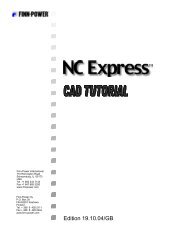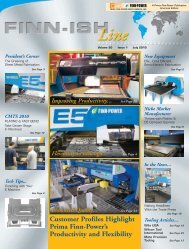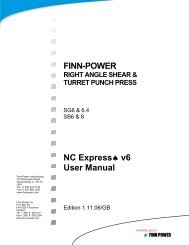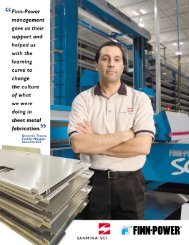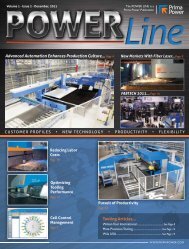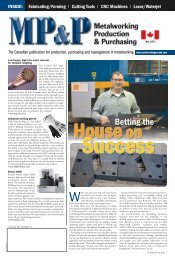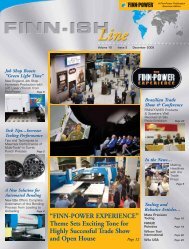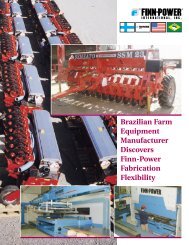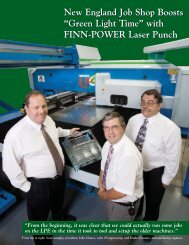Stand-Alone Punch machine user manual - Finn-Power International ...
Stand-Alone Punch machine user manual - Finn-Power International ...
Stand-Alone Punch machine user manual - Finn-Power International ...
You also want an ePaper? Increase the reach of your titles
YUMPU automatically turns print PDFs into web optimized ePapers that Google loves.
Plate margins can be set to a default value by clicking on ‘Use as default’ button<br />
on bottom left of dialog.<br />
5.1.4 Nesting Theory Summary<br />
Overall, the theory of nesting is to push the <strong>user</strong> to reach a state of automation when<br />
creating nests. All together, the items that are used to make a nest work correctly<br />
are easy to set or edit. Plates database stores information for plates and can be done<br />
in a one-time setup with many plates, only modifying quantities of plates or adding<br />
a new material type or thickness if needed. Parts database is used to sort the parts<br />
that have been created and stored in one or more part directories, allows easy access<br />
to part information. Plate definitions can be either used automatically or modified<br />
to liking, either way they are easy to set.<br />
Once the above items have been setup the ability to nest parts should be an easy<br />
task. The rest of the settings within the nest dialog are available to modify the<br />
outcome of a nest.<br />
5.2 Settings within Nest Dialog<br />
When the nest dialog is opened there are quite a few settings to enable or disable to<br />
change a nest’s outcome. The right combination can allow for the desired nest to be<br />
achieved.<br />
5.2.1 Part Separation<br />
Part separation is set both in the X-axis and the Y-axis. The values used within the<br />
nest dialog will be used to add spacing between tooling on parts. When a part is<br />
tooled within NC Express the geometry is no longer the outside of the part, the nest<br />
engine considers the outside edge of the tooling is to be the actual outside perimeter<br />
of the part. Within NC Express this is termed as “tooling envelope”. When tools<br />
are placed on the outside of the part, the amount of distance the tool is outside the<br />
external geometry of the part forms this imaginary envelope (window) around the<br />
outside of the part. This allows the parts to be nested as close as possible, but still<br />
not allowing tools to overlap onto other parts. True shape nesting is still used<br />
depending on the shape of the parts or tools used.<br />
When applying common line within a nest the X and Y value for spacing is used to<br />
apply the width of the tools used that are being common lined.<br />
5.2.2 Nest Accuracy<br />
Adjustments made to nest accuracy edit the step size for nesting parts. The value is<br />
an adjustment made by the end <strong>user</strong>. Increasing the accuracy will allow the nest<br />
engine to produce a nest much faster; also, using a large value, the part spacing may<br />
be larger than actual values entered. Decreasing the accuracy will make the nest<br />
engine run much slower, but will increase the potential for a higher quality nest. To<br />
achieve acceptable nest accuracy the end <strong>user</strong> should experiment with this value.<br />
5-82




